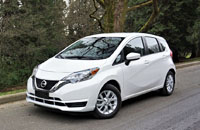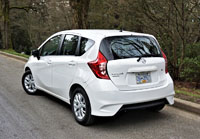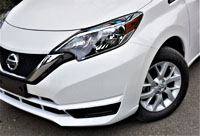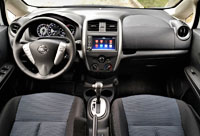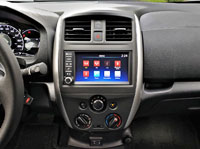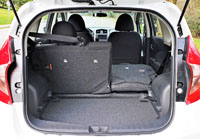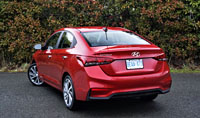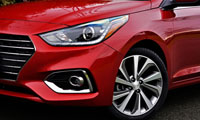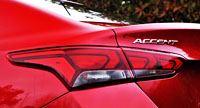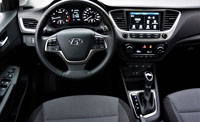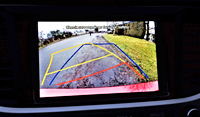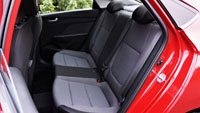
If you look at the 2018–2020 Hyundai Accent, you’ll be hard pressed to see any changes at all. The fifth-generation entry-level subcompact model arrived in sedan and hatchback form during calendar year 2017, and since then only had its trim levels changed from L, LE, GL and GLS to Essential, Preferred and Ultimate for the 2019 model year, and lost its four-door body style for 2020 (in Canada, the U.S. kept the sedan and dropped the hatchback).
Actually, there’s a lot more to the 2020 Accent than meets the eye, particularly a redesigned engine and all-new optional continuously variable transmission (CVT) for those wanting an automatic, replacing the 2019’s conventional six-speed auto. Another change is the elimination of the six-speed manual gearbox from top-line Ultimate trim, this version of the car only available with the CVT for 2020.

By the way, Hyundai isn’t the only automaker to kill off its subcompact sedan in Canada. Toyota dropped its Mazda-built Yaris Sedan for the 2020 model year too, while Nissan said so long to its Versa Note and won’t be offering the redesigned Versa sedan (that’s available south of the border) in our jurisdiction. Ford also discontinued its Fiesta four- and five-door variants after the 2019 model year, while Chevy dropped its Sonic the year before that, all of which leaves Kia and its Rio as the only choice for sedan buyers in the subcompact class.
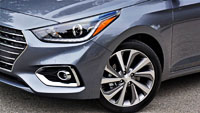
The 2020 Accent’s new 1.6-litre Smartstream engine replaces a very dependable four-cylinder of the same displacement, with the new one optimized for fuel economy over performance. The 2020 mill has actually lost 12 horsepower and 6 lb-ft of torque for a rating of 120 horsepower and 113 lb-ft compared to 132 horsepower and 119 lb-ft of torque in the 2019 car I last tested. In a car so small and light, this should make a significant difference, but it’s possible Hyundai has worked magic in the car’s manual and new CVT transmissions, so I’ll have to test the new one to know for sure.
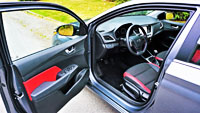
On the positive the new 2020 Accent is rated at 7.8 L/100km city, 6.1 highway and 7.0 combined with its standard six-speed manual, or 7.3, 6.0 and 6.7 respectively with the more efficient CVT. The outgoing 2019 Accent’s claimed rating of 8.2 L/100km in the city, 6.3 on the highway and 7.3 combined for both the manual and auto makes it easy to see Hyundai’s reason for change. In this class their choice of fuel economy over performance makes a lot of sense, being that most buyers are choosing Hyundai’s least expensive model in order to save money. After all, those who want a performance car can opt for the new Elantra N or one of the even sportier Veloster trims.

Then again, the 2019 Accent 5-Door Ultimate I tested is really fun when powering away from stoplights, and it has no difficulty passing long semi-trailers on a two-lane highway. The six-speed manual is a joy to flick through its notchy double-H pattern, the clutch take-up is near effortless to engage and well sorted, making it as good for those wanting to learn how to drive manual as it is for seasoned pros, while the Ultimate model’s four-wheel disc brakes are strong (the two lesser trims get rear drums), and the 17-inch alloys make a difference when pushing it hard through tight corners. I’m not going to pretend this is some sort of hot hatch, but the Accent can hold its own through a set of fast-paced S-turns, while it’s very good on the open highway thanks to a fairly long wheelbase. I had no problem cruising in this car for the better part of a day, whether running errands around town or out on the freeway. After a weeklong test I found it comfortable and more than just capable, it was downright fun to drive.
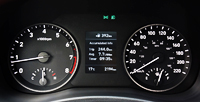
I know it’s more popular to opt for crossover SUVs than regular cars these days, but those looking to save a couple thousand might want to fall in love with something like this low-slung hatchback instead of its more rugged looking alternative. Yes, Hyundai’s new Venue is tempting at just over $17k, but you can get into an Accent for under $15k and you’ll be getting a larger, more accommodating car with better performance or fuel economy (depending on the year).

Put the two side-by-side and some will be forced to admit the sportier looking Accent has the edge on the Venue when it comes to styling too, but that will come down to personal taste, of course. The 2018 redesign did a lot to improve the Accent’s cool factor, thanks to big, bold grille and plenty of classy chrome elements to on this Ultimate model. The metal brightwork is most noticeable on the front fascia around the fog lights, also exclusive to this trim, while the side window mouldings and exterior door handles are chromed too. A set of LED headlights with LED signature accents also improve the look and functionality of this top-tier model, as does the set of LED turn signals infused into the side mirror caps, while its 17-inch multi-spoke alloys add class as well as some sporty character to the overall design.
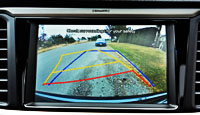
As mentioned a moment ago, the 2020 Accent Essential can be had for a mere $14,949 (plus freight and fees), which a lot less expensive than last year’s base price of $17,349. As it was (and still is, being that 2019 models were available at the time of writing), the 2019 Accent came standard with a Comfort Package that’s now extra. The 2020 Essential with Comfort Package starts at $17,699, while the price for the Accent’s second-tier Preferred trim line has jumped up from $17,549 in 2019 to $17,899 in 2020, and the as-tested Ultimate has increased its entry price by $1,250, from $20,049 to $21,649, but remember that it now comes standard with the CVT. Willing to take a guess what the upgrade from six-speed manual to six-speed automatic is in a 2019 Accent? Yup, $1,250.
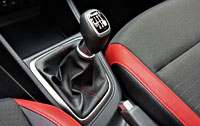
Important to note, Hyundai Canada is offering factory leasing and financing rates from zero percent on all 2019 Accent models, or up to $750 in additional incentives for 2020 Accents. To learn more, check out our 2020 Hyundai Accent Canada Prices and 2019 Hyundai Accent Canada Prices pages, where you can find out about available manufacturer rebates, manufacturer financing/leasing rates, and best of all, dealer invoice pricing that could save you thousands. We’ve even got a free CarCostCanada mobile app to make your shopping experience easier and less costly, so be sure to find out how our intelligent car shopping system can work for you when purchasing your next vehicle.
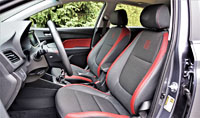
This is the largest Accent ever, by the way, which translates into a roomier, more accommodating car than most will expect in this class, particularly when it comes to interior width. The Accent’s seats provide a lot of adjustability, as long as you’re not hoping to adjust the driver’s lumbar support as there’s no way to do so, and while I would have like more pressure at my lower back, as well as deeper side bolsters, the Accent is a one-seat-fits-all compromise and therefore not capable of matching everyone’s body type perfectly. The rest of the seat’s adjustments were good, mind you, while the tilt and telescopic steering wheel’s reach was very good, enough so that my long-legged, short-torso body had no problem getting both comfortable and in control, which isn’t always the case in this class and some others.
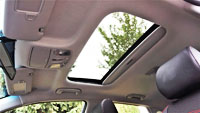
The rear seating area is spacious and comfortable as well, although those that want a centre rear armrest will need to look elsewhere. The seatbacks fold 60/40, however, expanding the already sizeable cargo area when needing to haul longer items. When lowered, the seatbacks sit about four inches above the load floor, so it’s not flat, but I was glad Hyundai chose to maximize available space instead of making it all level. A small spare tire and some tools are stowed underneath, and a hard-shell cargo cover rests above, all expected in this class.
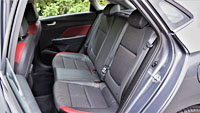
Less normal in this entry-level segment is the Accent Ultimate’s impressive cabin decor, not to mention its bevy of features. Access by proximity keyless entry ahead of starting the engine via button was a nice touch, while the interior is further spiced up with a two-tone red and black colour scheme. Hyundai doesn’t finish any cabin surfaces with soft-touch plastics, but all armrests are padded leatherette, and sharp looking seats are plenty soft of course, these finished with red leatherette bolsters, red stitching and some cool hexagonal embroidery on their cloth seatbacks. The red theme continues over to the door panel inserts, more red thread on the leatherette shifter boot, plus more on the inside rim of the leather-wrapped steering wheel.
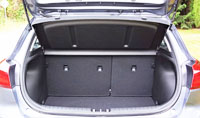
The steering wheel is really nice, incidentally, while its spokes come filled with extremely high-quality switchgear, the toggles on the left adjusting the audio system and surrounding buttons for audio mode control, voice activation, and phone use, while the ones on the right are for scrolling through the monochromatic multi-information display and the Accent’s cruise control system.

The instruments in front of the driver are simple and straight-forward, with bright backlit dials on either side of the just-mentioned multi-information display. More impressive is the bright, colourful and well-endowed 7.0-inch infotainment touchscreen on the centre stack, which includes Apple CarPlay and Android Auto smartphone integration, Bluetooth audio and phone streaming, regular audio functions, the latter including satellite radio, a large backup camera with moving guidelines, and more.
A single-zone automatic climate control system can be adjusted just below, which includes large dials for easy use while wearing winter gloves, while under that is a row of buttons for the three-way heatable front seats and even one for the heated steering wheel rim. Where the centre stack meets the lower console is a big tray for holding your smartphone, plus USB-A and auxiliary connections.
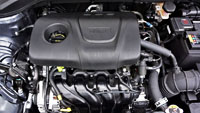
The top-line Accent Ultimate also includes a powered moonroof and forward collision warning with automatic emergency braking, by the way, while equipment pulled up from lesser trims include the tilt-and-telescopic steering column (the base model only gets a tilting wheel), cruise control, front seat heaters and the larger 7.0-inch centre touchscreen (instead of the 5.0-inch one on the base model) mentioned already, as well as automatic on/off headlights, six-speaker audio (an improvement over four speakers found in the base model), keyless access, and a USB-A charging port in the rear seating area from Preferred trim; the automatic transmission and Bluetooth noted before, plus power-adjustable and heatable side mirrors, air conditioning and powered windows from the Essential Comfort package; and finally variable intermittent front windshield wipers, a manually adjustable six-way driver’s seat, a manually adjustable four-way front passenger’s seat, and power door locks from the base Essential model.
There’s a lot to like about today’s Accent, especially when factoring in value. Add in a five-year, 100,000 km comprehensive warranty and it all starts making sense. If you’re not wholly sold on a new subcompact SUV like Hyundai’s Venue or Kona, I recommend you take a closer look at the Accent, and when you do, don’t forget to choose a 2019 model for performance or 2020 to save more on fuel.
Story and photo credits: Trevor Hofmann
Photo editing: Karen Tuggay

